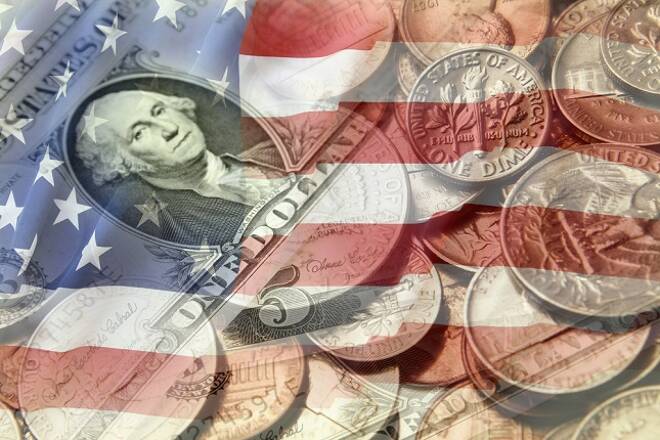Advertisement
Advertisement
Year-on-Year U.S. Core PCE Price Index Rises to 1.6 Percent
By:
The personal consumption expenditures (PCE) price index excluding the volatile food and energy components rose 0.2 percent last month after advancing 0.3 percent in January. That lifted the year-on-year increase in the PCE Price Index to 1.6 percent, the biggest gain since February 2017, from 1.5 percent in January.
Most financial, commodity and currency markets were confined in a narrow range on Thursday with many of the world’s key markets closed for the Good Friday holiday. End-of-the-month and end-of-the-quarter position-squaring throughout the week also opened the door for many of the major players to even take an early holiday as evidenced by below-average volume.
There were a few U.S. economic reports that helped give the markets some direction, but other than the strong surge in U.S. equity markets and a spike in natural gas, the trading action was muted.
Core PCE Price Index
The Core PCE Price Index, the Federal Reserve’s preferred inflation measure, showed moderation in monthly inflation readings after prices pushed higher in January. The personal consumption expenditures (PCE) price index excluding the volatile food and energy components rose 0.2 percent last month after advancing 0.3 percent in January.
That lifted the year-on-year increase in the PCE Price Index to 1.6 percent, the biggest gain since February 2017, from 1.5 percent in January. It should be noted that the PCE Price Index has been below the U.S. central bank’s 2 percent target since mid-2012.
Looking ahead, economists believe the annual core PCE price index could accelerate to 1.9 percent in March as last year’s weak reading drop out of the calculation.
Personal Spending
The U.S. Commerce Department reported on Thursday that consumer spending, which accounts for more than two-thirds of U.S. economic activity, increased 0.2 percent last month after posting a similar gain in January.
Spending on long-lasting goods, such as motor vehicles, rebounded 0.2 percent after tumbling 1.5 percent in January. Outlays on services rose 0.3 percent, matching January’s increase. Economists had forecast consumer spending increasing 0.2 percent in February.
The steady rise in inflation last month also helped curb consumer spending. When adjusted for inflation, consumer spending was unchanged in February after falling 0.2 percent in the prior month. That suggests a sharp slowdown in consumer spending in the first quarter after it surged at an eye-popping 4.0 percent annualized rate in the fourth quarter.
Personal Income
In February, personal income rose 0.4 percent and has now increased by the same margin for three straight months. Wages increased 0.5 percent last month after climbing 0.6 percent in January.
The government also said that savings increased to $497.4 billion in February, the highest level since August 2017, from $471.3 billion in the prior month. The savings rate rose to a six-month high of 3.4 percent from 3.2 percent in January.
Unemployment Claims
The U.S. Labor Department reported on Thursday that the number of Americans filing for unemployment benefits fell to more than a 45-year low last week, suggesting the economy remains strong despite signs of a slowdown in the first quarter.
Initial claims for state unemployment benefits dropped 12,000 to a seasonally adjusted 215,000 for the week-ended March 24, the lowest level since January 1973. Data for the prior week were revised to show 2,000 fewer claims received than previously reported. Economists had forecast claims falling to 230,000 in the latest week.
Chicago PMI
The Chicago Purchasing Managers Index (PMI) unexpectedly fell to a one-year low in March. Chicago PMI came in at 57.4, below the previously reported 61.9 and the 62.1 forecast. This report is important because it’s a leading indicator or economic health. Businesses tend to react quickly to market conditions, and their purchasing managers hold perhaps the most current and relevant insight into the company’s view of the economy.
Revised University of Michigan Consumer Sentiment
The University of Michigan said consumer confidence ended March at its strongest level in more than 14 years even after slipping slightly compared to its mid-month preliminary report.
The report showed consumer attitudes about the economy inched down to a reading of 101.4 at the end of March. Economists expected the reading to remain at 102, the same as mid-March, when the index jumped from 99.7 at the end of February.
The index dipped into the end of March due to uncertainty about the impact of the proposed trade tariffs, according to the report. Concerns over trade policies offset positive reactions to recent tax reform legislation.
Revised University of Michigan Inflation Expectations
The Revised University of Michigan Inflation Expectations report showed a reading of 2.8%, down slightly from the previously reported 2.9%.
About the Author
James Hyerczykauthor
James Hyerczyk is a U.S. based seasoned technical analyst and educator with over 40 years of experience in market analysis and trading, specializing in chart patterns and price movement. He is the author of two books on technical analysis and has a background in both futures and stock markets.
Did you find this article useful?
Latest news and analysis
Advertisement
